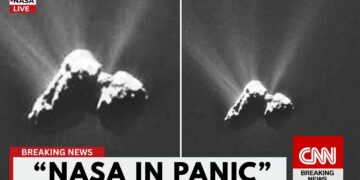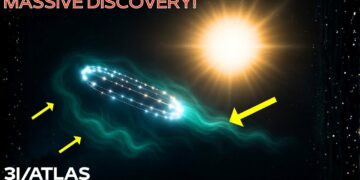A meteor crashed into Mars on Christmas Eve 2021, and shook the planet so much that NASA’s InSight lander recorded the rumblings.
Scientists didn’t know where the quake came from until NASA’s Mars Reconnaissance Orbiter, a spacecraft circling the red planet, captured images of the new impact crater. NASA revealed the discovery on Thursday.
“It was immediately clear that this is the biggest new crater we’ve ever seen,” Ingrid Daubar, InSight impact science lead, said in a press briefing. “It’s about 500 feet wide or about two city blocks across. And even though meteorites are hitting the planet all the time, this crater is more than 10 times larger than the typical new craters we see forming on Mars.”

The discovery is promising for NASA’s plan to one day send astronauts to Mars.
To avoid excessively hostile weather, NASA would prefer to land astronauts close to the equator. But wherever those explorers go, they’ll need to mine water, both for basic human needs and to break it down into hydrogen and oxygen to provide rocket fuel for the journey home.
Meteor-impact Mars quakes can help solve a centuries-old mystery

“This is really exciting,” Doyeon Kim, a geophysicist at ETH Zurich, who analyzed data from those quakes, told Insider, adding, “This was one of the mission goals, to detect and identify surface waves.”
Their findings from those meteor impacts, published in two studies in the journal Science on Thursday, may help solve a centuries-old mystery about the geography of Mars.
For almost as long as astronomers have studied Mars, they’ve wondered why its northern and southern hemispheres look so different. The North is flat lowlands, while the South is full of mountains.
According to Kim, there are two leading theories for this juxtaposition. One is that the North and South are made of two different types of rock. The other is that the planet’s crust is simply thicker in the South. Whatever the answer is, it would be another piece in the complex puzzle of how Mars formed, which is a model for how other rocky planets around other stars may have formed.
The surface waves from the meteor impacts gave scientists a peek at the nearby Martian crust. It’s a small sample of the crust, so it can’t solve the North-South mystery on its own, but it fits into the second theory: that the crust is thicker in the South and thinner in the North.
“This just provides a single or a tiny piece of evidence to start to uncover the mystery,” Kim said.
InSight is dying

“For the last four years, the lander has been collecting a lot of dust on its solar panels,” Bruce Barnerdt, the principal investigator for the Insight mission, said at a press briefing Thursday. “We’ve been sort of cutting back on the operations of the spacecraft as that’s happened in order to squeeze out as much science data as we can.”
A recent dust storm could’ve been the final nail in the coffin, but it skirted past InSight’s location. Still, it filled the Martian atmosphere with dust particles, reducing the amount of sunlight that gets to the ground.

























